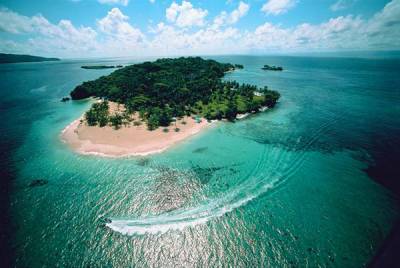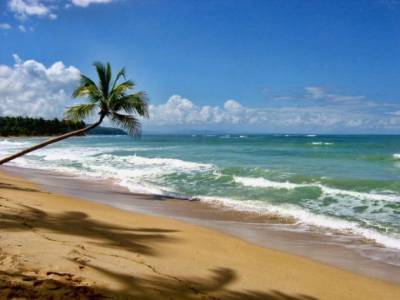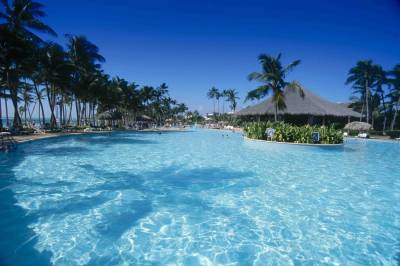Haiti
The Republic of Haiti - an island country in the West Indies. In the north by the Atlantic Ocean in the south - the Caribbean Sea. It occupies the western half of the. Haiti (eastern - Dominican Republic), a member of the Greater Antilles, and several small islands (Gon, cake, your, etc.). Windward Passage to the north-west is separated from the adjacent on. Cuba. The area - 27.8 thousand square meters. miles.

The area of the. Haiti is mountainous: on the north-west to south-west stretch along the North Ridge of Mount Montagne Noire and Mato. In the North-West Peninsula are the mountains of Nor-west, south-east - the mountain
La Celle in the country with the highest peak of La Celle (2674 m) and along the Peninsula Tibyuron - From the ridge. To
the north-east of the North Ridge North is plain, the ridge between the
North and the mountains of Montagne Noire - Central Plateau, between
the mountains and Matho La Celle - lowland basin Cul-de-Sac to the lake.
Somatr. Along the coast stretch of coral reefs.
On
the shores of a tropical trade wind climate (average January
temperature of +22 ° C, July +28 ° C), in the mountains - cool (in
January +7 ... +14 ° C). Periods of rain: April-June, September and November. On the windward slopes of the mountains fall 1250-2500 mm of rainfall per year, on the leeward - 500-800 mm. There are hurricanes. River
Grande Rivière du Nord and Les Trois-Rivieres flowing into the Atlantic
Ocean, Artibonite - in the Gulf of Gonaïves, Jacmel - in the Caribbean
Sea. The largest lake - Ethan-Somatr and Peligr.

Head of the Republic of Haiti - the president, parliament - the two chambers of the National Assembly. The territory is divided into nine departments.
Population - 7656 thousand.: 95% - negros, 5% - mulatto and white. 80% of believers - Catholics, 16% - Protestants. However, in reality 90% of the population profess the cult of voodoo - belief in the magical power of the deities' loa. " Official language - French, but 90% of the population speaks Creole.
The
country is the poorest in the West Indies (80% of the population lives
below the poverty line), it is an international financial assistance. Gross
domestic product in 2002 amounted to 10.6 billion dollars, GDP per
capita - $ 1,400 50% of GDP provide services, 30% - agriculture, 20% -
industry. The main branch of the economy - agriculture. Irrigated agriculture is developed only in the northern plains and valleys of the Artibonite, and Cul-de-Sac. Grown
on the export of coffee, agave (sisal make out of it), mangoes,
sugarcane, rice, and for local consumption - cotton, citrus, bananas,
corn, millet, cassava. Cattle, goats. In the mountains, is a valuable timber harvesting. Sisal processing factories, risoochistitelnaya and sugar industries. In addition they are also cement plants, hydropower plants on the river. Artibonite, is assembling electronics, sporting goods and manufactured toys. Crafts: pottery ornaments, woodcuts, wooden masks, woven baskets. Main exports: coffee, cocoa, sisal, vegetable oil, citrus fruits. The major exporters - the U.S., the Dominican Republic.
In 2002 the country was visited by 140 thousand foreign tourists. They
are attracted by protected rain forests, sea beaches (including the
black sand), the rituals of voodoo (a mixture of guinea pagan traditions
and rituals with Catholicism, dance in the courtyards of temples,
divination by entrails cock, the recovery of dead). The main celebrations are held in July voodoo. The
main natural tourist sites: the underwater karst cave "Hole Zombie" sea
sponges "Elephant Ear" Blue Pool (3 lakes with water color of cobalt,
joined waterfalls), caves in the park of La Visit. But tourism is primarily developed greatly reduced due to political instability.

Capital
- Port-au-Prince (originally L'Hopital) - located in the center of the
country, on the banks of the beautiful bay of Port-au-Prince Gong Bay
(Caribbean). Population - 1119 thous., In agglomerations - 1764 thousand was founded in 1749 by the French. Often suffered from earthquakes and fires. In
1770, out of Cap Haitien was moved here the capital of the French
colony of San Domingo, with the 1804 is the capital of Haiti. The country's largest sea port of export. Conducted small-scale assembly of electronics, advanced textiles, cement and tobacco. Mais Gate Airport, 8 km north of the city. University
of Haiti, the three technical university, conservatory, Centre for
Research in Humanities and Social Sciences, Institute of Ethnography,
Endocrinology, National Library. Museums: National, ethnographic, archaeological, artistic center, a gallery of plastic arts. The
main attraction is the National Palace (1918), military barracks and a
statue of Jean-Jacques Dessalines (the hero of the war for
independence), Notre Dame (1915), wooden houses in the fashionable
districts of the former, a stone embankment (1780), the house voodoo. The elite live in a suburb in the cool hills Petonvil to the south-east of the city. The outskirts of the city - solid slums, where there is no hygiene, signs of poverty everywhere.